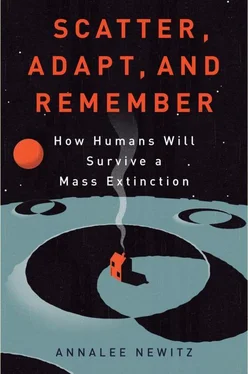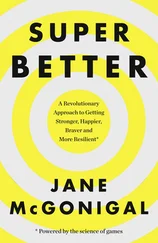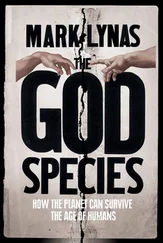Many highly adaptable or generalist species began invading new watery territories. That meant they were competing with the local specialist species, like trilobites, for food. A specialist species requires very specific temperatures or food sources. They couldn’t cruise all over the Devonian oceans eating anything that came into view the way sharks could. So when invasive species came into their territories and stole their food, the specialists had nowhere to go. Their populations dwindled and they went extinct. By the end of the Devonian mass extinction, the planet was covered with giant, homogenous inland oceans where you’d see the same generalist species no matter where you looked. And out of those circumstances, Stigall believes, you had the makings of a mass extinction.
Though Stigall’s account is only one of many theories about mass extinction in the Devonian, her claims are backed up by evidence that many of the creatures who survived the period were generalists like sharks—creatures who could live anywhere and eat almost anything. Another survivor was the humble crinoid, a starfish-like creature with several feeding arms surrounding its mouth that make it look a little like the “face-hugger” stage of the creature in Alien. The crinoids went through a floating larval stage that allowed them to drift into many new environments before attaching to the ground and feeding on the abundant plankton in the water.
Still, homogenous ecosystems like the ones in the Devonian would have left all life-forms primed for disaster. Generalist species may be hardy, but they also share the same vulnerabilities. Say, for example, a drought hits an ecosystem in the Midwest. If there is only one type of wheat species, and it can’t deal with higher temperatures or less moisture, a short-term climatic change could kill off every blade of wheat in a given region. Without a diverse range of grain species, which might have different moisture tolerances, drought slays all the wheat. This in turn kills the animals who feed on that wheat, whose deaths leave predators hungry, too. Soon, you have multiple extinctions because the whole food chain has been ravaged. “The more we cull diversity, the more we are vulnerable to extinction,” Stigall concluded. It’s very possible that this is how the Devonian came to a close, with only a few invasive species scraping by until speciation, or new species evolution, made the ecosystem diverse again.
For Stigall, there’s a lesson in the fossils that surround her home, remnants of an inland sea unlike anything that exists now. “We’ve got the same problem with invasive species today,” she said. “It’s not caused by sea levels, but by humans, because we like to move things around.” She described how invasive species like pigeons and rats, as well as some trees and grasses, have gone from a few local regions to expand across the Earth. If this trend continues, she predicted that “long term, what you expect is a huge decimation of total biodiversity.” We could be on our way back to the late Devonian, in the early stages of a mass extinction that begins with a depression in speciation and ends with deadly homogenization.
Sometimes, the urge to live by expanding into as many territories as possible can backfire. As the invasive species of the Devonian reveal, life does not always beget more life. Some ways of living can actually kill just as handily as climate change and radiation.
As devastating as the Ordovician and Devonian mass extinctions were, they were nothing compared to what ravaged the planet about 75 million years later. The “Great Dying,” as it is known among geologists, was the worst period of mass death the Earth has ever known. It’s very likely that this event had no single cause; it was set off by a combination of disasters from the physical world and the biological.
THE BERKELEY GEOCHRONOLOGY CENTER, a lab devoted to studying the ancient ages of Earth, is located on a pleasant tree-lined ridge overlooking UC Berkeley. Somewhat puzzlingly, it shares a building with the Church Divinity School of the Pacific. While seminary students strolled by in the hall outside, I met Paul Renne, the center’s head geologist, a big, jovial man in a T-shirt. As he walked me through a warren of labs—full of the lasers and mass spectrometers that I’d come to expect in such places—I realized there was a peculiar kind of symmetry to the Geochronology Center’s tenancy arrangement with the Divinity School. After all, I had come to ask Renne about the closest thing to a total apocalypse the planet has witnessed.
The Permian Period (299 Million–251 Million Years Ago): Life in the Time of Megavolcanoes
Two hundred fifty million years ago, at the end of the Permian period, Earth spent thousands of years dying. At the end of those millennia of carnage, almost 95 percent of the species on the planet were dead. It was the worst mass extinction in our planet’s history, earning it the moniker “the Great Dying.”
The first phase of the mass extinction was caused by a disaster that has left an indelible and easily deciphered mark upon the Earth. If you visit the vast area known as the Siberian Traps today, you’ll find a beautiful, hilly terrain covered in short grasses. But 250 million years ago, the region was drowning under liquid rock spewing from the ragged mouth of a megavolcano. As its name implies, a megavolcano is far more powerful than your typical lava-filled mountain. Renne and other geologists estimate that as much as 2.7 million square kilometers of basaltic lava swept across the land in a fiery deluge. Almost a million square kilometers of the hardened basalt rock still remains here, smoothed by erosion into plateaus and valleys. It’s unclear whether this almost unimaginable ocean of lava was unleashed by one or two enormous eruptions, or a single, ongoing eruption that lasted for centuries.
But the Great Dying wasn’t caused by flaming tides of death. Volcanic eruptions on a large scale release a lot of gases, including greenhouse gases like carbon dioxide and methane. Jonathan Payne, a geologist at Stanford, estimates that the eruptions unleashed 13,000 to 43,000 gigatons (a gigaton is 1 billion tons) of carbon into the atmosphere. As if that wasn’t enough, they also released highly reflective sulfur particles that remained suspended in the atmosphere, scattering light away and cooling the climate very rapidly. The culprit responsible for the Great Dying was climate change.
Ironically, the roiling fires from this Siberian megavolcano may have caused a brief ice age. As glaciation locked coastal waters into ice sheets, the sea level dropped, and another source of greenhouse gas was unleashed. It’s possible that the water dipped low enough to expose methane clathrates, huge deposits of frozen methane that cling to the edges of continental shelves deep beneath the ocean. The clathrates melted and released ancient methane, a powerful greenhouse gas. As quickly as it began, the Permian ice age would have ended with a more intense greenhouse than before. These radical transformations in the atmosphere and climate made it impossible for most creatures to survive. Food sources dwindled. Species upon species died out.
It was an ugly ending for the Permian, which had been a time of rapid animal evolution on land. When the megavolcano began erupting, the earliest ancestors of today’s mammals were walking the Earth. Gingkos and conifers covered the coasts in forests, while seeded ferns evolved, uncurling their leafy fronds beneath tall pines. Mammal-reptile hybrids called synapsids roamed the land, some looking like giant lizards, and some like small rhinos. One of them, the enormous, dragon-like predator dimetrodon, had a tall sail attached to its back like a bony fin, and was such a badass hunter that paleontologists believe it may have fed upon sharks. These creatures all thudded around on the same continent because plate tectonics had finally pushed the planet’s landmasses together into one enormous continent called Pangaea, which stretched from pole to pole. A globe-wrapping ocean called Panthalassa teemed with sea creatures, from tiny single-celled organisms to corals and large fish.
Читать дальше






![Аннали Ньюиц - Автономность [litres]](/books/424681/annali-nyuic-avtonomnost-litres-thumb.webp)





